A portable kerosene heater provides localized heat by burning oil. This unvented space heating device is used either for supplemental heating or as an emergency heat source when the power goes out. It operates like a kerosene lamp, using a fiberglass wick to draw kerosene from a tank. The wick emits flame into a burner unit that heats nearby objects through radiation or uses convection to warm the air.

Since kerosene heaters are no vented, products of combustion are released into the air. These include low levels of carbon monoxide and nitrogen dioxide and if the heater is not fueled, adjusted, or maintained properly, additional pollutants may be released. If the heater is used within a poorly ventilated area, it could present a health risk so manufacturers typically recommend cracking open a window or door during use.
The heater should be kept three feet from any material that can burn. It should only be refueled after heating and in a well-ventilated area, preferably outdoors. The proper grade of fuel should be used and gasoline should never be used in a heater designed to be fueled by kerosene. Some communities prohibit the use of kerosene heaters so check municipal codes prior to use.
The open flame of a kerosene heater represents an explosion risk if a flammable vapor is present. A kerosene heater that runs out of oxygen may produce unsafe amounts of carbon monoxide and soot. Installing smoke and carbon monoxide alarms reduces the risk of smoke inhalation, fire, and carbon monoxide poisoning.
A kerosene heater should never be left unattended and should not be left on after the user goes to sleep. Follow the manufacturer guidelines for use and if the heater appears to be malfunctioning, discontinue use and have a professional repair it. Taking these safety precautions should provide safe enjoyment of this supplemental heating unit for years.

Recent Comments